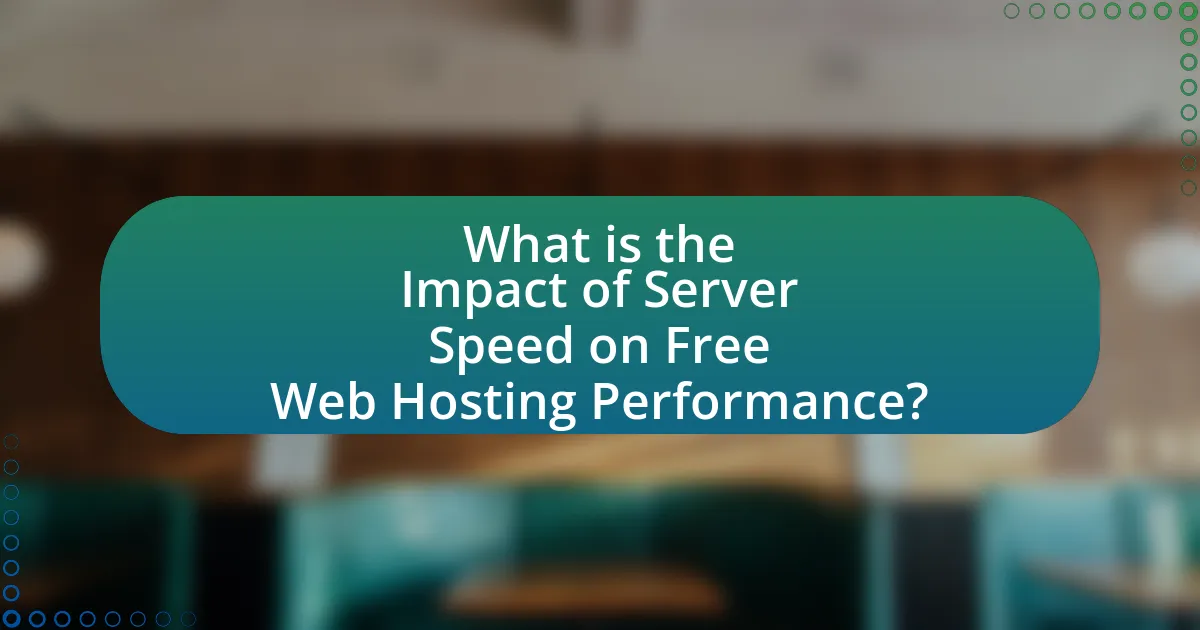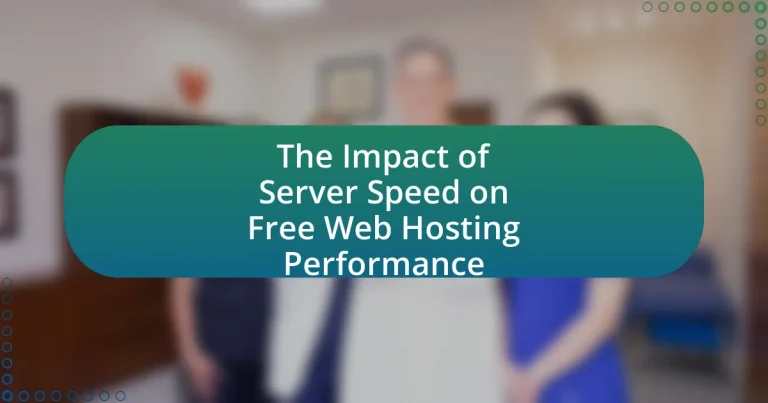Server speed is a critical factor influencing the performance of free web hosting services, directly affecting website loading times, user experience, and search engine rankings. Faster servers lead to reduced latency and improved loading times, which are essential for retaining visitors and maximizing conversions. The article explores how server speed impacts website performance, the key factors determining server speed, and the limitations of free hosting services that often result in slower speeds. Additionally, it discusses the financial implications of slow server speeds, best practices for enhancing server performance, and tools available for assessing server speed, providing a comprehensive overview of the importance of server speed in the context of free web hosting.

What is the Impact of Server Speed on Free Web Hosting Performance?
Server speed significantly affects free web hosting performance by determining how quickly websites load and respond to user requests. Faster server speeds lead to reduced latency and improved loading times, which are crucial for user experience and search engine rankings. Studies show that a one-second delay in page load time can result in a 7% reduction in conversions, highlighting the importance of server speed in retaining visitors. Additionally, free web hosting services often utilize slower servers due to resource limitations, which can exacerbate performance issues, leading to longer load times and potential downtime.
How does server speed influence website loading times?
Server speed directly influences website loading times by determining how quickly data is processed and delivered to users. A faster server can handle requests more efficiently, reducing latency and enabling quicker retrieval of web pages. For instance, studies show that a one-second delay in server response time can lead to a 7% reduction in conversions, highlighting the critical role of server speed in user experience and engagement. Additionally, Google has indicated that page speed is a ranking factor in search results, further emphasizing the importance of server performance in both loading times and overall website effectiveness.
What are the key factors that determine server speed?
The key factors that determine server speed include hardware specifications, network bandwidth, server configuration, and software optimization. Hardware specifications, such as CPU speed, RAM size, and storage type (SSD vs. HDD), directly influence processing power and data retrieval times. Network bandwidth affects the amount of data that can be transmitted to and from the server, impacting load times. Server configuration, including the setup of web servers and databases, plays a crucial role in how efficiently requests are handled. Lastly, software optimization, which involves coding practices and resource management, can significantly enhance performance. For instance, a study by the University of California, Berkeley, found that optimizing server configurations can reduce response times by up to 50%.
How does server speed affect user experience and engagement?
Server speed significantly impacts user experience and engagement by determining how quickly web pages load and respond to user actions. Faster server speeds lead to reduced loading times, which studies show can decrease bounce rates and increase user satisfaction; for instance, a one-second delay in page load time can lead to a 7% reduction in conversions, according to research by Akamai. Additionally, improved server speed enhances the overall interactivity of a website, encouraging users to explore more content and spend more time on the site, thereby increasing engagement metrics such as page views and session duration.
Why is server speed critical for free web hosting services?
Server speed is critical for free web hosting services because it directly affects website performance, user experience, and search engine rankings. A faster server ensures quicker loading times, which is essential since studies show that a one-second delay in page load time can lead to a 7% reduction in conversions and a 16% decrease in customer satisfaction. Additionally, search engines like Google prioritize fast-loading websites in their rankings, meaning that slow server speeds can negatively impact visibility and traffic. Therefore, for free web hosting services, maintaining optimal server speed is vital to attract and retain users while enhancing overall site performance.
What limitations do free web hosting services typically have?
Free web hosting services typically have limitations such as restricted bandwidth, limited storage space, lack of customer support, and the presence of advertisements. These constraints often result in slower server speeds and reduced performance, as users may experience throttling during peak times due to bandwidth caps. Additionally, the limited storage can hinder the ability to host larger websites or applications effectively. The absence of reliable customer support can lead to prolonged downtime and unresolved technical issues, further impacting user experience. Lastly, advertisements placed by the hosting provider can detract from the website’s professionalism and user engagement.
How does server speed differentiate free hosting providers?
Server speed significantly differentiates free hosting providers by affecting website loading times and overall performance. Faster servers enable quicker data retrieval and processing, leading to improved user experience and lower bounce rates. For instance, studies show that a one-second delay in page load time can result in a 7% reduction in conversions. In contrast, many free hosting providers often utilize slower, shared server resources, which can lead to increased latency and downtime. This disparity in server speed directly impacts the reliability and efficiency of websites hosted on these platforms, making speed a critical factor in choosing a free hosting provider.
What are the consequences of slow server speeds on free web hosting?
Slow server speeds on free web hosting lead to decreased website performance, resulting in longer loading times and potential user frustration. This can cause higher bounce rates, as users are likely to abandon a site that takes too long to load; studies show that a one-second delay in page response can result in a 7% reduction in conversions. Additionally, slow speeds can negatively impact search engine rankings, as search engines prioritize fast-loading sites in their algorithms. Consequently, businesses relying on free web hosting may experience diminished online visibility and reduced traffic, ultimately affecting their overall success.
How does slow server speed impact search engine rankings?
Slow server speed negatively impacts search engine rankings by increasing page load times, which can lead to higher bounce rates and lower user engagement. Search engines like Google consider page speed as a ranking factor; studies show that a one-second delay in load time can reduce conversions by 7% and increase bounce rates by 32%. Consequently, websites with slower server speeds may rank lower in search results, as search engines prioritize user experience and faster-loading sites.
What are the potential financial implications for users of slow servers?
Slow servers can lead to significant financial implications for users, primarily through lost revenue and increased operational costs. When server response times are prolonged, users experience delays that can result in decreased customer satisfaction and higher bounce rates; studies show that a one-second delay in page load time can lead to a 7% reduction in conversions. Additionally, slow servers can increase the cost of customer acquisition as businesses may need to invest more in marketing to attract new users who may leave due to poor performance. Furthermore, the potential for reduced search engine rankings due to slow load times can lead to decreased organic traffic, further impacting revenue. Overall, the financial consequences of slow servers can manifest in both direct losses from decreased sales and indirect costs from increased marketing efforts and operational inefficiencies.
How can users assess server speed when choosing free web hosting?
Users can assess server speed when choosing free web hosting by utilizing online tools such as Pingdom, GTmetrix, or WebPageTest, which measure load times and performance metrics. These tools provide insights into how quickly a website hosted on a specific server responds to requests, allowing users to compare different hosting options effectively. Additionally, users can check reviews and performance benchmarks from existing customers to gauge the reliability and speed of the hosting service.
What tools are available to measure server speed effectively?
To measure server speed effectively, tools such as Pingdom, GTmetrix, and WebPageTest are available. Pingdom provides real-time monitoring and performance insights, allowing users to analyze load times and uptime. GTmetrix combines Google PageSpeed Insights and YSlow metrics to evaluate website performance and offers recommendations for improvement. WebPageTest allows for detailed testing from multiple locations and browsers, providing comprehensive data on loading times and performance bottlenecks. These tools are widely recognized for their accuracy and reliability in assessing server speed.
What best practices can enhance server speed in free web hosting?
To enhance server speed in free web hosting, optimizing website content and utilizing caching techniques are essential practices. Optimizing website content involves compressing images, minifying CSS and JavaScript files, and reducing the number of HTTP requests, which collectively decrease load times. Caching techniques, such as browser caching and server-side caching, store frequently accessed data to reduce server load and improve response times. According to Google, optimizing images can reduce page load times by up to 80%, demonstrating the significant impact of these practices on server speed.
How can website optimization techniques improve performance?
Website optimization techniques can significantly improve performance by enhancing loading speed, reducing resource consumption, and improving user experience. Techniques such as image compression, minification of CSS and JavaScript, and leveraging browser caching directly contribute to faster page load times. For instance, Google reports that a one-second delay in mobile load times can reduce conversions by up to 20%. Additionally, optimizing server response times through content delivery networks (CDNs) can further decrease latency, ensuring that users experience quicker access to content. These improvements not only boost user satisfaction but also positively impact search engine rankings, as faster websites are favored by algorithms.
What role does content delivery network (CDN) play in server speed?
A content delivery network (CDN) significantly enhances server speed by distributing content across multiple geographically dispersed servers. This distribution reduces latency, as user requests are routed to the nearest server, minimizing the distance data must travel. For instance, Akamai, a leading CDN provider, reports that using a CDN can reduce load times by up to 50% compared to traditional hosting methods. By caching static content closer to users, CDNs alleviate the load on the origin server, allowing it to respond more quickly to dynamic requests. This optimization directly contributes to improved website performance and user experience, particularly for free web hosting services that may have limited server resources.
What common troubleshooting steps can improve server speed?
To improve server speed, common troubleshooting steps include optimizing server configurations, upgrading hardware, and managing resource allocation effectively. Optimizing server configurations involves adjusting settings such as memory limits, connection timeouts, and caching mechanisms to enhance performance. Upgrading hardware, such as increasing RAM or switching to SSDs, can significantly reduce load times and improve response rates. Additionally, managing resource allocation by monitoring CPU and memory usage helps identify bottlenecks, allowing for targeted improvements. These steps are supported by studies indicating that optimized configurations and upgraded hardware can lead to performance enhancements of up to 50% in server response times.




